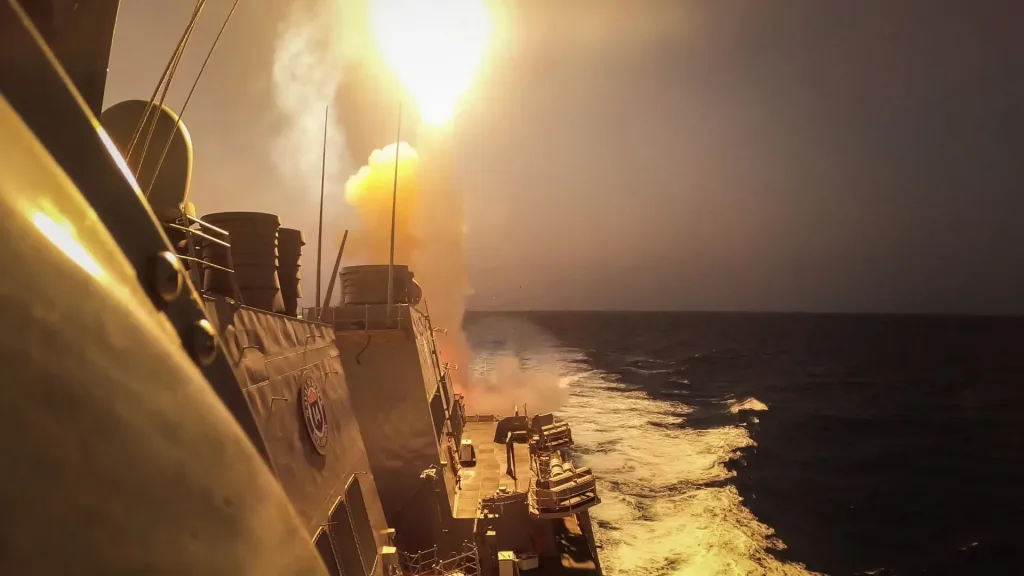Air and Missile Defence: Lessons from Ukraine and Israel
This article looks at three of the key lessons for air and missile defence that were raised during the recent RUSI IAMD conference in London. The overriding theme is that air and missile defence requires trade-offs, ones that are likely difficult and politically charged.
On the 24th April, the Royal United Services Institute (RUSI) in London held its annual Integrated Air and Missile Defence conference. There, speakers provided their observations and lessons learned from Ukraine and Israel in the field of air defence. Despite covering two quite different wars, the speakers revealed a series of common threads that are worth further analysis and consideration. Starting with the political challenges associated with defending a nation’s skies.
Air and missile defence priorities

Iron Dome interceptors make their way towards rockets during the 2021 Operation Guardian of the Walls. Credit: Israeli Air Force.
“We need politicians to tell us what not to defend,” or words to that effect were said by Brigadier General Ran Kochav, former commander of the Israeli Defence Force’s Air Defence Command. This may come as a surprise to some, Israel arguably has one of the most comprehensive air defence capabilities in the world when compared with the size of air space that it defends. But this sentiment was echoed by other speakers for Europe and NATO in the context of a threat from Russia throughout the conference. With limited air defence assets, and a lot of airspace to defend, NATO countries would face difficult choices about what and how to defend against massed Russian attacks of the type that are being conducted against Ukraine.
So, the first lesson is clear; politicians need to make difficult decisions about what to defend as we cannot protect every city. For example, Germany has announced its intention to procure Arrow 4 from Israel, providing defence against hypersonic and ballistic missiles, bringing the country’s complement of air defence systems up to 29. But there are 80 cities in Germany, and at least 11 air bases including three operated by the US. This means that even with a very well-resourced ground-based air defence component, Germany would likely be unable to defend all of its territory, and nor would any other European state. There is strength in numbers, and Europe would no doubt work together, combining ground-based air defence with naval assets and combat air to degrade Russian air strikes. But Russia has shown that it can deploy thousands of missiles and drones in coordinated strikes and determined campaigns spanning years, not days.
“When you see swarms of hundreds of drones now operating in Ukraine, some of them decoys, some of them with munitions on board, the challenge is how do you tackle them all or do you tackle them all?” Air Commodore Blythe Crawford remarked during the event. And this is really key, Europe might be able to withstand an initial assault, but eventually, it is likely that Russian strikes would outstrip the available interceptors and difficult decisions would have to be made about what to defend.
Omnidirectional sensing

A Ukrainian mobile air defence team. They have been key to Ukraine’s air and missile defence, providing a cheap and scalable response to Russia’s massed use of drones like Shahed. Credit: Territorial Defence Force of Ukraine
Air and missile defence is as much about sensors as it is interceptors. Detection has to be a 24/7 capability, Brig Gen Kochav explained. This is hard for the personnel involved, they have to train to improve, they have to sleep and rest, and they have to keep watch. But this is not all, in Israel and Ukraine, air and missile attacks use a cocktail of capabilities requiring different sensors for detection and tracking. Both conflicts also require omnidirectional defence, including sensors and interceptors. As pointed out by Bogusz Madej, a Policy Officer at the IAMD Section in NATO’s Defence Investment Division, Russia is capable of very complex attacks with a heavy emphasis on one way attack drones. In some attacks, pairs of cruise missiles will approach a city before separating at the last minute to approach from opposite sides. In others, Shahed one-way attack drones will fly circuitous routes around Ukraine before diving for their target, forcing Ukraine to try and monitor as much of its airspace as it can.
Israel too has faced attacks from all directions, including rockets fired from Gaza, rockets, missiles, and drones from Lebanon in the North, ballistic missiles and drones from Iran, drones from Syria, and ballistic missiles and drones from Yemen, according to Kochav. Thousands of rockets, missiles and drones have been fired at both Ukraine and Israel, deciding which threats are most dangerous requires ample warning and detection at as early a stage as possible. This means 360 degree sensing to identify threats coming from unexpected directions, more sensors and more types of sensors, including space-based assets and passive detection systems. An element of interoperability is also key, sharing threat data between systems enables a more effective air and missile defence response, as has been demonstrated through the US Army’s IBCS. At the same time, adversaries are working to reduce the radar cross section of their weapons, introducing new materials and radar reflectors, as Russia has done with its decoy drones known as Parody. This makes detection and an accurate understanding of the threat more challenging.
In sum, omnidirectional detection is important for several reasons. Adversaries have shown the ability to launch sustained attacks over long periods of time. They learn and adjust their tactics in the process, a point laboured by Madej, leading to complex approach patterns and strike packages. Omnidirectional sensing helps an air defence force coordinate its response, and when combined with clear political direction about what to defend, ensures that the most critical targets have the greatest potential to withstand an attack.
The threats are complex

USS Carney intercepts a Houthi threat. Sub-peer opponents now pose a credible challenge to air and missile defence capabilities. Credit: US Navy
Almost every speaker emphasised that one of the challenges that comes from complex layered threats is the threat response, which shifts the economics of war, meaning a state may be obliged to respond to an attack using weapons that cost much more than what they are intercepting. Tens of thousands of missiles, rockets, and drones have been launched at Ukraine and Israel, requiring remarkable expenditures of air defence interceptors. But it is not just the mass of threats, it is the diversity in both theatres that must drive air defence decisions. “We don’t want to be shooting drones down with Patriot,” Madej said. This effect has also been observed in the Red Sea, on the 30th November 2024, the Houthis fired three anti-ship ballistic missiles, three one-way attack drones, and an anti-ship cruise missile at merchant vessels in the Red Sea, forcing two US ships to intervene and intercept many of the threats. That single engagement likely cost tens of millions of dollars. Israel’s defence against Gaza’s rocket attacks has cost billions of dollars, with some nights likely costing a billion dollars or more. There is a cost element to air defence, as well as a magazine depth component, and resource management. “Sophisticated resource management during saturation attacks is also key,” Kochav remarked. This means having reloads prepared and ready, knowing the routes between depots and air defence batteries, as well as the length of time that reloading takes. This must all be combined with lessons one and two, helping a force to resource its air and missile defence according to the political demands, and the focus of the threat.
Efforts are underway to increase Europe’s stocks of air defence missiles as well as its ability to manufacture them. But a confrontation with Russia would likely require tens of thousands of air defence interceptors with different capabilities and costs. Here, low-cost solutions like high energy lasers may provide a more sustainable solution to the large-scale use of drones like the Shahed, or mobile air defence teams as employed by Ukraine. However, often simple adjustments can reduce the effects of simple solutions. Increasing the altitude that Shaheds fly at, for example, has blunted the ability of Ukraine’s mobile air defence teams to engage them, leading to a reliance upon helicopters to conduct air-to-air interceptions.
In terms of capability, western states are well-served in their ability to engage high end threats insofar as missiles have been developed that can intercept hypersonic and ballistic missiles. Israel has intercepted more than 90% of the ballistic missiles fired at it, according to Kochav, and Ukraine routinely intercepts more than 80% of the cruise missiles and drones that Russia launches. However, it is apparent that a low-cost solution is needed alongside these exquisite capabilities to reliably engage and destroy smaller drones and other munitions that are dangerous if left untouched, but do not require a highly specialised missile interceptor with a production time measured in years.
Buying time
In many ways, the lessons of air and missile defence from Ukraine and Israel identified by the speakers are unsurprising. They are challenges and problems that have been known since air defence was formulated as a counter to the introduction of air power, and persisted throughout the Cold War. However, perhaps the key to understanding the current context is a point made by Madej during his address, “defence alone will never be enough for deterrence, it buys time but will never be complete.” If the decade since Russia first invaded Ukraine has shown anything, it is that building political consensus takes time, even around acute issues like an attack on a friendly state. In this context, air and missile defence serves to keep a nation’s population and war-fighting capital safe and ready to respond, but it should also buy time for political consensus to form and an adversary’s actions to be properly interpreted. Properly configured air and missile defence can mitigate escalation – Iran’s attacks against Israel achieved very little because of the effective air defence, leading to a proportionate Israeli response. But, imagine what would have happened if all of Iran’s missiles had found their targets. In Ukraine, Russia would have succeeded in destroying Ukraine’s energy infrastructure, defence industry, air force, and command centres were it not for the very capable air defence network maintained by the Ukrainian Air Force.
There are other important elements of air and missile defence that were touched on during the conference, but warrant further attention. One of them is the nature of air superiority, which has certainly changed, but the way it has changed and its role is likely to be the subject of coming discussions. One element that was decidedly unaddressed is how air and missile defence would change in the event of war with a nuclear-armed opponent. It is common for European spokespeople to say that we need to draw lessons from Ukraine in terms of how Russia fights, but few seem to want to address the fact that Russia has tactical nuclear warheads, and that it would be more likely to use them against NATO than Ukraine. This would likely be a defining factor of a war between NATO and Russia, the impact of which requires consideration.
By Sam Cranny-Evans, published on 8th May, 2025.

Sign Up for Updates!
Get insider news, tips, and updates. No spam, just the good stuff!






